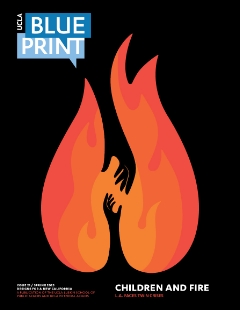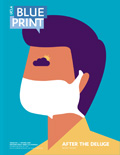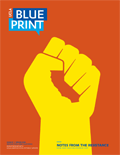In retrospect, Jan. 4 was not a good day to move to Altadena.
I’d had misgivings, based in part on the weather forecast. It was going to be windy. Really, really windy, with hurricane-force blasts as strong as in 2011, when super-Santa Anas felled thousands of trees, including a thick-trunked pine that very nearly crushed our Highland Park house. Maybe it wasn’t the best time to move into a tiny rental surrounded by huge trees.
Also, I wasn’t ready. I was still boxing up books, notes, personal mementos — things to surround myself with for a three-month stay while our own house was being renovated. My pile included a children’s novel that my father had read to my sister and me when I was in kindergarten, and that I would finally read on my own 60 years later. Photos I would at last digitize, to protect them from time and the elements. Binders with hard-to-find reports from L.A. city and county files, for future newspaper and magazine stories.
But the contractors would be pulling out our plumbing and knocking down walls on Monday. Unable to decide what to leave in the garage, I took everything to Altadena. Sure, it might get windy that first week at our new place on Palm Street, just west of Lake Avenue. But it would be windy everywhere.
I was immediately happy about the move. Altadena was so close to home yet had such a different feel, such friendly neighbors, such a great view of the mountains. And the house — a cute little place, perfect for lunch with friends after hitting the trails through the oaks and canyons a few blocks north. You could see Eaton Canyon from the front yard.
And our cat seemed to be OK with her new digs.
As the wind increased on Tuesday, I stocked up on flashlight batteries at Altadena Hardware, knowing the power would probably be spotty in all that blowing. I picked up blueberry muffins at Amara Cafe and had lunch at Fox’s, a wonderful 1950s coffee shop where the former owner was eating, as the waitress said he did the first Tuesday of every month.
I made a mental note of the nearby landmarks to check out later in the week when the wind died down. Like the eccentric Bunny Museum. A collection of mid-century homes by modernist architect Gregory Ain. The Queen Anne-style Andrew McNally House.
That evening, as my wife, Dana, and I ate dinner and listened to the wind, we caught the scent of something ominous. Smoke. I walked outside and looked northeast. Eaton Canyon glowed bright orange.
Our instinctive L.A. wildfire protocols kicked in. Leaving Dana’s car behind, we put the cat in mine and grabbed whatever we might need for a night away. We saw a few of our neighbors doing the same. But as newcomers we didn’t know the local routine, so we escaped down Lake toward the freeway. The road was blocked here and there by uprooted trees. Not branches. Whole trees.
Working her smartphone, Dana landed us a pet-friendly hotel room in Arcadia. But on our arrival the building was pitch-black — no power, no rooms. Lights were on at a hotel next door, so Dana booked a room there instead.
In the lobby, the power flickered, and the computers went down as a woman ahead of Dana at the counter tried in vain to register. A long line of anxious people with dogs on leashes and cats in carriers materialized behind them in the dark. Because of Dana’s quick fingers on the smartphone, we grabbed the last available room.
At the end of a fitful night, there was no sunrise, just a lighter shade of gray to the east and the toxic stench of smoke and a coating of ash on every outdoor surface. One night at the hotel became four. Fire trucks with out-of-state logos lined the parking lot. It was still not safe to re-enter our neighborhood, so we spent hours sitting on the bed, phones in hand, searching on various apps for evidence of our house’s fate. Maps showed black marks where buildings had been destroyed, but our block had not yet been assessed. So there was hope.
In the elevator, younger and more daring fire refugees shared notes about various back routes to their homes, or whatever was left of them. In the lobby, stunned older folks sat, usually silent, but willing, if asked, to talk about their houses and the generations who had lived there. Most hadn’t fled until late on the night of the fire. There had been no evacuation orders until well after midnight, with houses already burning.
We learned later that at least 17 people died in or near their Altadena homes. The toll across town in Pacific Palisades was at least 12.
On the fourth day, on a weather satellite photo, we finally picked out our lot. Empty.
When at last we were allowed to return to the ruined site, we saw one frighteningly wobbly wall of stucco left, and a few pipes. One wooden chair sat in the front yard as if nothing had happened. Everything else was rubble and ash.
Also completely gone were the places where, it turns out, I had been one of the last-ever customers — the hardware store, the restaurant, the cafe. And the places I had planned to see — the Bunny Museum, the historic architecture.
I felt oddly guilty, as if by setting one foot in Altadena, I had caused the entire community to vanish before the other foot came down.
Altadena is a community of layers, like the strata you can see on the walls of the Grand Canyon. Built by grape growers who liked the climate and the freedom from municipal temperance laws, then by Midwesterners headed to tuberculosis sanatoriums and board-and-care homes. Then artsy bohemians, and then Black homebuyers elbowed out of other communities because of discriminatory lending practices. And then a new wave of invigorating or gentrifying (take your pick) young buyers, attracted by the quirkiness, the mutiracial neighborhoods, the relative affordability. As newcomers, we had barely waded into that most recent layer. Even the places we visited in our abbreviated three-day stay in Altadena were outposts of familiar places closer to home. There’s still an Amara Cafe in Highland Park, where we can get blueberry muffins. Cindy’s in Eagle Rock has the same owners, and much the same menu, as the now-destroyed Fox’s.
It wasn’t until we had fled to the Arcadia hotel that we met, spoke and commiserated with people from Altadena’s deeper, more rooted — yet now tragically uprooted — layers.
We mourned our losses, counted our blessings (two cars, quick fingers on the smartphone, a home to return to in a few months’ time) and found a rental in Eagle Rock. Dana’s car, the one we’d left behind, weirdly survived intact on the street next to our incinerated house. I drove it away. As I did, I pretended that lost Altadena might rematerialize out of our view, available, Brigadoon-like, to the people who lived there, even if not to short-termers like us. I’d freely trade away the precious things we lost in the fire to make that happen.
But this is Los Angeles, where magical endings are reserved for the movies.
























